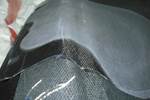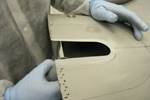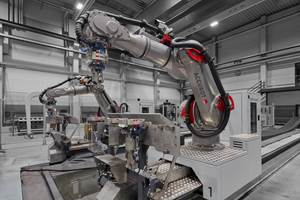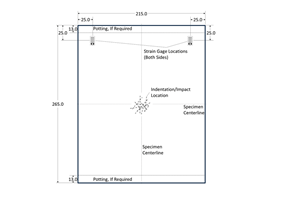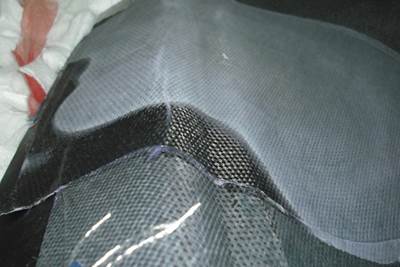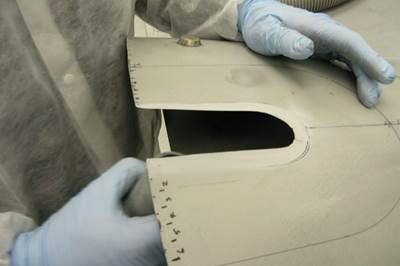Determining steel/composite failure load of bonded repair assemblies
Bureau Veritas and partners use a novel equivalent interface test specimen and simulation to predict failure load in bonded composite patch repairs to steel structures.
For steel-structured ships and offshore oil and gas production units, corrosion is a constant threat and maintenance an ongoing challenge. The most common “crop and renew” repair technique uses “hot work” to remove the damaged area and replace it with new welded steel plates and stiffeners. However, this presents a challenge for operators, especially in ATEX environments where there is a risk of explosion due to flammable gases. This repair method requires production to stop and can be lengthy, resulting in high maintenance costs. Shipyards and operators are looking for an alternative solution.
Bonded composite patch repair offers a “cold” technique that achieves high mechanical properties without stopping production or compromising safety. However, few bonded repairs to steel structures have been qualified by classification societies — the organizations that develop and apply technical standards for the design, construction and survey of ships and offshore production units. Even more challenging is the application of bonded composite repairs to large areas which contribute to the primary strength of the steel hull and girder structure.
In this context, the classification society Bureau Veritas Marine & Offshore (Nantes, France) and its partners — TotalEnergies, Petrobras, Naval Group, Siemens, Cold Pad, InfraCore Co. and University Gustave Eiffel — launched the Joint Industry Project (JIP) StrengthBond Offshore in 2019 to develop a methodology for the design and evaluation of bonded composite repairs to steel structures. Determining the failure load of such composite/steel assemblies is complex as it involves mixed material interfaces which cannot be represented with standard specimens during mechanical property characterization. When designing bonded assemblies, a simple approach involves stress analysis with analytical or numerical models. However, additional issues must be considered when studying complex geometries and loadings. For the case presented here, a fracture mechanics approach using finite element analysis (FEA) was chosen, using a cohesive zone model to represent the behavior at multiple interfaces and to determine when and where failure occurs.
Materials, equivalent interface specimen for cohesive law characterization
The studied composite bonded repair was fabricated using dry plies of glass fiber and carbon fiber fabric. However, glass fiber plies were located only between the carbon fiber plies and the steel surface to reduce interfacial stresses and isolate the carbon fiber from the steel to prevent galvanic corrosion. The resin used was a 180°C cure epoxy, the steel plates were grade S355 and for all specimens the steel substrates were sandblasted and degreased before laminating. Two manufacturing methods for the carbon fiber-reinforced polymer (CFRP) repair patch were compared: resin infusion and hand layup. Both methods used a vacuum bagged cure and post-cure.
When using the classical approach for the characterization of a cohesive law for such multiple interfaces in a composite patch repair, it is necessary to investigate the glass fiber-reinforced polymer (GFRP)-to-steel interface, the GFRP ply-to-ply interface, the CFRP-to-GFRP interface and the CFRP ply-to-ply interface for the different loading modes. To limit the number of physical coupon tests, a new kind of sample, which includes all the different interfaces, was designed based on existing ASTM standards: D5528 double cantilever beam (DCB) in mode I, D7905 end notched flexure (ENF) in mode II and D6671 mixed mode bending (MMB) for mixed mode I and II. This equivalent interface (EI) specimen (Fig. 1) was used for all of the tests. It’s worth noting that this concept strongly depends on the thicknesses of the interfaces and/or involved interphases and should therefore be validated if another interface arrangement is studied.
A Teflon film, used to create the beginning of a crack, was positioned at the edge of each specimen and between each interface. Standard test benches were used to characterize the cohesive law used in subsequent numerical simulations (Fig. 2).

Figure 2. Experimental investigations on the EI specimens using (a) ASTM D5528 DCB in mode I, (b) ASTM D7905 EENF in mode II and (c) ASTM D6671 MMB in mixed mode I and II.
Numerical simulations
FEA was performed in Simcenter Nastran (Siemens Digital Industry Software, Plano, Texas, U.S.) with the SOL402 solver formulation for cohesive elements based on continuum damage mechanics. The elements used in the model were solid volume elements with isotropic properties for the steel substrates and 3D orthotropic properties for the CFRP and GFRP plies. In-plane properties were based on experimental tests while out-of-plane properties were calculated from Bureau Veritas rules NR5461. Geometry and boundary conditions are shown in Fig. 3. Because Teflon was inserted at every interface, contact was applied at each interface except the CFRP/CFRP middle interface where nodes were merged. Contact surfaces were applied with default parameters from the SOL402 solver and no friction was used. For MMB testing, the beams of the test bench were modeled using rigid elements. A cohesive element layer was introduced at the interface between the steel and the first ply of GFRP.
A bilinear cohesive law shape was used for modeling the crack propagation. For pure mode I and mode II, three different parameters must be calibrated: the critical energy release rate (ERR) 𝐺𝑐, the initial stiffness 𝐾 and the critical stress before damaging 𝜎𝑐/τc. An example of mode I cohesive law is shown in Fig. 4, where 𝑑 refers to damage.
Comparison with testing
A stiffness sensitivity analysis was performed for the DCB and ENF models and revealed that the stiffness (values from 102 to 106 megapascals/millimeter) has almost no influence on numerical force-displacement curves. The critical ERR has a lot of influence on the results but it is fixed from the experimental tests. Thus, the calibration of the cohesive parameters to fit to experimental results was achieved mainly by varying the critical stress before damaging — σc for DCB tests and τc for ENF tests.
Figure 5. Comparison of numerical and experimental force-displacement curves for DCB (top) and ENF (bottom).
Results for the DCB peel critical stress sensitivity is shown in Fig. 5 (top graph). A small critical stress of 2 megapascals accurately represented the experimental behavior, with a progressive damage that started early in the tests. Fig. 5 (bottom graph) shows a comparison between numerical and experimental force-displacement curves for ENF tests. Four configurations were used as suggested on the standard, with four different initial crack sizes. Numerical results — shown as dotted lines in Fig. 5 — accurately represented the behavior during tests. In this testing, a smaller slope at the start, resulting from the testing setup, induced some lateral offset but once displacement passed 0.5 millimeter, the global stiffnesses converged for both numerical and experimental curves. The calibration of the critical shear stress was based on the failure load at one configuration and tested on the other three configurations. The difference between numerical and experimental failure load remained below 5% for all configurations.
The coupling parameter was also calibrated from MMB tests, with the final cohesive parameters shown in Table 1.
Application on large-size specimens
Large-size specimens have been tested in tension and in bending by the laboratory SMC of the University Gustave Eiffel (Bouguenais, France) for both short (slope 1/3) and long scarf (slope 1/10) composite patch repairs produced by infusion. Additional long scarf specimens were manufactured by hand layup. The tensile tests were performed on an Instron (Norwood, Mass., U.S.) tensile machine with an ultimate capacity of 2,500 kilonewtons. Three-point bending tests were carried out on a Losen press with a capacity of 300 kilonewtons. Fig. 6 shows large-sized (≈2,000 × 50 millimeter) specimens installed in the test benches.
All specimens were monitored with strain gages installed on the steel substrate and at the extremities of the patch. Optical fibers were also used, embedded in the composite patch between the first glass fiber plies, close to the steel substrate and also on the surface of the patch. The objective of such monitoring was to be able to identify the crack initiation and the crack propagation into the patch, for a better understanding of the behavior and the correlation with the numerical simulations.
Static tests of long scarf-infused specimens have been modeled in symmetrical 3D finite element models using the same meshing as EI models (Fig. 3). The parameters, entered in cohesive laws and solved with Siemens Simcenter Nastran SOL402, are based on previous toughness tests led on representative EI specimens in pure mode I, mode II and mixed mode.
As there is a competition between two interfaces — the steel/first GFRP ply and the first GFRP ply/second GFRP ply — for the experimental crack propagation, two configurations were tested with a cohesive element layer at only one interface for each model. Results for long scarf specimens subjected to tensile loading and bending loading are presented in Table 2. In bending loading, experimental failure always occurred at the first interface but results for both interfaces are presented. Results are given for a mesh size of 0.5 millimeter except for bending first GRP ply – second GRP ply, in which a mesh size of 1 millimeter was used.
Table 2. Numerical failure loads of long scarf specimens in tensile and bending compared to experimental results.
Numerical models were able to correctly predict the behavior in tensile loading while there were some discrepancies in bending loading. Some investigations remain to compare crack initiation and crack propagation obtained via the optical fiber measurements with the numerical simulations.
Conclusion
The newly designed non-standard specimen developed within the JIP StrengthBond Offshore program enables predicting the failure load of a composite bonded patch repair to steel structure with good accuracy, especially in tension. In comparison with other calculation methods — including the stress criterion, coupled stress-energy criterion and linear elastic fracture mechanism (LEFM) — the presented approach with a cohesive law, determined by using equivalent interface specimens, gives better results. However, some investigations still need to be performed for bending loads and particularly for the calibration of the coupling parameter from MMB tests. Moreover, additional tests are needed to improve the robustness of the methodology, especially on the equivalent interface sample geometry. This could be achieved through a parametric analysis on the results or investigations on alternative materials.
As the effect of the environment is not considered in this project, Bureau Veritas launched a new Joint Industry Project, JIP DuraBond Offshore, in November 2024 to investigate the influence of temperature, water and hydrocarbons on the resistance of such bonded composite patch repairs to steel structures.
References
For more details on the JIP StrengthBond Offshore project, the following papers have been published:
1Sourisseau et al., “Use of equivalent interface samples during fracture mechanics investigations for the design of adhesively bonded composite reinforcements on steel structures,” SMAR2024
2Deydier et al., “Design assessment of composite patch repair on steel structures based on toughness tests using a newly designed non-standard “equivalent interface” specimen,” ECCM21, 2024
3Paboeuf et al., “Static and fatigue strength assessment of composite patch repair,” OMAE2024
4Sourisseau et al., “A new adhesively bonded composite repair for offshore steel structures: strength assessment and fatigue,” CICE 2023
5Paboeuf et al., “Strength assessment methods for adhesively bonded repair,” OMAE 2023
6Sourisseau et al., “Assessment of a new methodology for bonded composite repair on offshore structures,” JNC2023
7Deydier et al., “Application of cohesive elements on large bonded steel patch specimens, based on cohesive law calibrated with standard tests,” DRMS 2023
8Sourisseau et al., “Development of composite patch for offshore steel repair,” DRMS 2023
9Sourisseau et al., “Adhesively Bonded FRP Reinforcement of Steel Structures: Surface Preparation Analysis and Influence of the Primer,” OMAE 2022, https://doi.org/10.1115/OMAE2022-79079
10Sourisseau et al., “Use of infrared spectrometry and wettability measurement for surface characterization before bonding operations,” JNC 2022
11Sourisseau et al., “Suivi de la propagation de fissure par fiber optique “continue” dans des joints collés lors d’essais MMB,” CFM 2022
12Sourisseau et al., “Use of Distributed Optical Fiber to Monitor the Crack Propagation of an Adhesively Bonded Joint During an ENF Test,” CICE 2021, https://doi.org/10.1007/978-3-030-88166-5_21
13Sourisseau et al., “Use of high spatial resolution distributed optical fiber to monitor the crack propagation of an adhesively bonded joint during ENF and DCB tests,” International Journal of Adhesion and Adhesives, https://doi.org/10.1016/j.ijadhadh.2022.103124
14Stephane Paboeuf et al., “Towards a Robust Offshore Bonded Repair Strength Evaluation,” SNAME 26th Offshore Symposium, Virtual, April 2021. https://doi.org/10.5957/TOS-2021-14
Related Content
ORNL demonstrates lightning strike protection tech for composites
Researchers, led by Vipin Kumar, developed a low-cost, recyclable carbon fiber wind turbine blade tip that showed resilience to high-voltage lightning strikes, with more innovations in store.
Read MoreAutomated robotic NDT enhances capabilities for composites
Kineco Kaman Composites India uses a bespoke Fill Accubot ultrasonic testing system to boost inspection efficiency and productivity.
Read MoreDamage tolerance testing of sandwich composites: The sandwich CAI test
A new ASTM-standardized test method established in 2022 assesses the compression-loaded damage tolerance of sandwich composites.
Read MorePhotothermal tomography for locating, quantifying defects in composites
Years of infrared testing development result in thermography technology that is no longer just qualitative, but can define defect size and depth, making additional UT scans obsolete.
Read MoreRead Next
Developing bonded composite repair for ships, offshore units
Bureau Veritas and industry partners issue guidelines and pave the way for certification via StrengthBond Offshore project.
Read MoreAlternate heat sources for hot-bonded composite repairs
Successfully using an alternate heat source for repairing composite structures requires an awareness of thermal dynamics and effective heat transfer management.
Read MoreAerodynamic considerations when repairing complex composite structures
An example process gives steps and issues to consider when determining the most effective repair method for preserving the aerodynamic surface of a complex-contoured composite sandwich structure.
Read More


